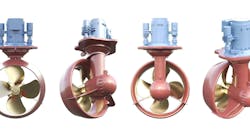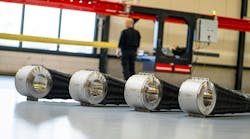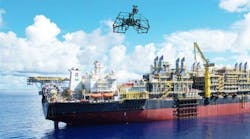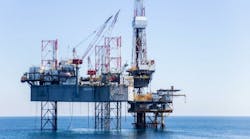Stephen Hall
Tata Steel
Deepwater linepipe usually has a small diameter and thick wall, which by definition is a pipe with a high thickness to diameter (t/D) ratio. For pipe manufacturers who deploy the UOE process, the creation of linepipe with a high t/D ratio, rather than necessarily the manufacture of specific deepwater linepipe, represents the greatest challenge. As the limit state for the design of such linepipe is not guaranteed to be collapse resistant, the manufacturer has to produce a high t/D linepipe that can meet the most demanding design limit state requirements, with any specific collapse element coming through extra testing.
For low t/D linepipe, the predominant collapse mechanism is elastic, and is controlled primarily by the dimensional performance of the linepipe. For high t/D linepipe, one of the most frequently dominant collapse mechanisms that influence the design is plastic collapse. The mechanical strength and shape of the linepipe control this.
The key factors for the manufacture of a deepwater linepipe are consistency of both the dimensional and mechanical properties around the circumference and along the full length of the pipe. The pipe manufacturing route can influence a number of factors in the DNV OS-F101 collapse equations, which, when optimized, can yield improvements in the collapse resistance of UOE linepipe. Understanding the design requirements and the UOE manufacturing process are essential to manufacture a product that exhibits all the desired qualities. If the intrinsic collapse resistance of the pipe can be increased, there are benefits of cost reduction, increased safety margins, and facilitation of laying at greater depths and speeds.
A model solution
Due to the stringent requirements for deepwater, it is essential to manufacture high t/D linepipe to the necessary quality in a commercially viable way. Each step of the forming process must be fully understood from both theoretical and operational perspectives. Finite element (FE) modeling and validation of the individual processes within the UOE manufacturing route allow the dies for each step of the process to be designed at the optimum specification. This is essential to give good shape of the final pipe at commercial a production rate.
The UOE forming processes for high t/D linepipe involve large amounts of pressure, and the possibility of equipment damage is high if the process is not controlled. The use of modeling, which has been validated on previous projects, allows the design of the pressing dies to be optimized. This optimization allows the minimum level of pressing force necessary to be used, thereby reducing both the risk of damage to the equipment and risk to the mill's ability to complete an order on time and in full to the necessary standard of quality.
Each of the forming processes impacts the other steps in the whole UOE process. An understanding of these interactions is necessary to establish a process which is optimized to deliver quality linepipe. For example, a good crimp profile for shape control out of the O-press, which allows consistent weld preps and reduces the peaking on the final product, is essential as this not only affects the final product quality in terms of shape (peaking cannot be fully removed by the expander) but also can have a large impact on the throughput of the mill by allowing the welding to run optimally.
FE modeling allows the design of dies that not only give the correct shape and profile but also, due to the bespoke nature of the process, reduce the amount of wear. This gives better shape control while reducing costs associated with lower quality and throughputs.
Modelling and validation are essential tools to understand the UOE process with respect to the manufacture of high t/D pipe. Strain reversals on the material during the forming process in the UOE mills are unavoidable and necessitate the de-ration of the pipe manufactured through this process due to the Bauschinger effect. This fabrication factor for the pipes is a calculated value. Tata Steel believes these fabrication factors should be used as a design tool only, not as a quality control tool. Quality control should be determined by whether the actual test results meet the tensile and compressive minimum yield strengths set out in the specification.
The way forward?
Natural progression within the industry has been to develop higher t/D ratio products at X65 strength, and the next logical step is to increase the specified grade to X70 to give more mechanical resistance to collapse. The manufacture of high t/D linepipe involves application of large forces during each stage of the UOE forming process, and an increase in strength of the starting plate material requires larger forces to be applied during forming.
To prove the UOE process for the manufacture of a high t/D linepipe, it is essential that the manufacturer understands the dimensional and mechanical properties along the entire length of the linepipe manufactured this way.
The in-service pipeline is subject to large external hydrostatic pressure along its entire length during its operational lifetime. To show this phenomenon and to try and understand what the variation is at various points around the ring, a trial was carried out to quantify the differences both around the circumference and along the full length of an X70 grade linepipe, and to demonstrate the consistency of the UOE manufacturing process.
Test success
The data from the manufactured linepipe for the mechanical properties showed a normally distributed X70 tensile and compressive yield strength at Rt 0.5, which comfortably exceeded the 0.85 fabrication factor associated with the UOE process. The testing regime showed the properties were consistent regardless of where along the pipe the tests were taken. However, there was some variation for tests taken around the circumference of the ring due to the different stresses of the individual processing stages. The most conservative location of 180° to the weld was where the standard production testing was taken. All the results of the tests at the 180° position passed the requirements and showed that if tested at this location, it was appropriate to assume that this was the minimum performance for the entire pipe.
Practical application testing of collapse resistance should be done in a way that ensures a valid result in a turnaround time that allows sensible release timings to be maintained. There are three main tests for collapse with varying degrees of conservatism and viability for production release testing. The first and most "service" realistic option is the full-scale pipe collapse test; however it is impractical to use this method for production testing due to cost and logistics. Validation of the UOE manufacturing method and benefits associated with the low temperature heat treatment of the coating process have been reported, and shows the relationship among the different methods and the varying degrees of conservatism associated with each.
The preferred production release test is small-scale compression testing, which is the most conservative of the three options. Small-scale test pieces can be taken as part of the routine release tests and results can be generated within a sensible time. The test is carried out per ASTM-E9, with the sampling of the material taken in a way that ensures all the grain size variations are sampled equally.
The other subtlety that requires consideration is the strain rate of the test. The current experience and calibrations for mills are based on the ASTM-E9 strain rate, which should be maintained for any testing. The other is the small-scale ring collapse test, which is between the full-scale and compression tests in terms of conservatism. This not only allows the mechanical collapse strength to be tested but also the influence of any imperfections in the shape of the pipe or ring. This is a midpoint between the other two tests, and is realistic because a ring of the material is tested. It can also be done at a sensible rate for testing on an extended basis (e.g. one in 10 heats).
Dimension data
The second important factor for high t/D linepipe is the dimensional performance along its length. A major factor in the collapse limit state equation is the ovality of the manufactured linepipe, with a perfect circle giving the best collapse resistance.
The performance of the UOE process is excellent, with an ovality level of less than 0.5% of the outside diameter. This level of ovality has a positive impact on the fit up of the linepipe for laying operations and also on the collapse resistance of the pipeline. All other dimensional measurements taken during the trial show the excellent performance of the UOE process against the applicable standards.
Conclusion
To produce linepipe suitable for deepwater applications it is essential that a UOE pipe mill manufacture high t/D pipe with consistent mechanical and dimensional properties along the entire length of the pipe. To do this, a UOE mill can use modelling and validations, along with comprehensive data analysis, to ensure the products meet all the necessary property specifications. Trials show that Tata Steel's processes can deliver linepipe with excellent dimensional and mechanical performance to offer benefits in both collapse resistance and faster fit up during welding for offshore pipelines.
The author
Stephen Hall is manager-technical support and development within the SAW Mills at Hartlepool, UK. He holds a BSc (Hons) in Applied Chemistry, and a MSc in Project Management.







